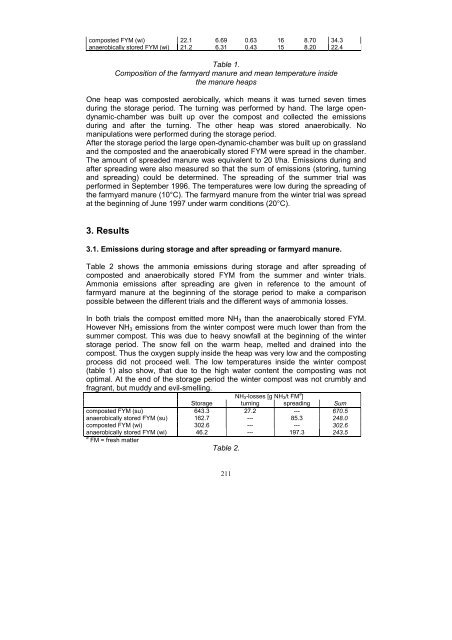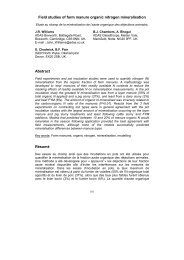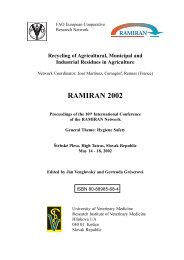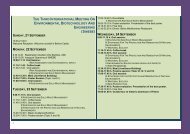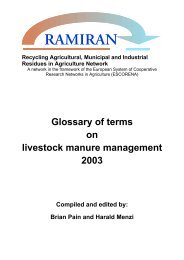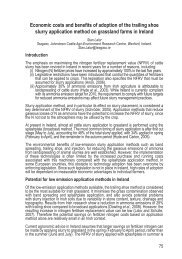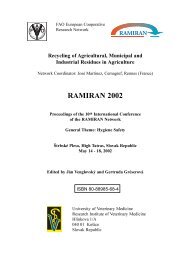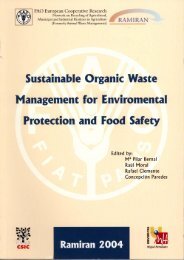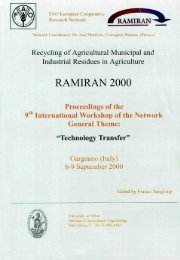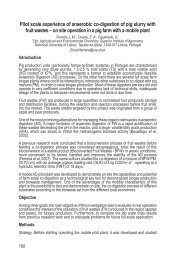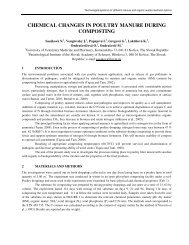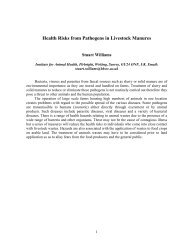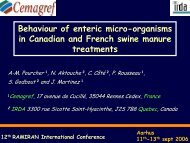Emissions of NH3, N2O and CH4 from composted and ... - Ramiran
Emissions of NH3, N2O and CH4 from composted and ... - Ramiran
Emissions of NH3, N2O and CH4 from composted and ... - Ramiran
Create successful ePaper yourself
Turn your PDF publications into a flip-book with our unique Google optimized e-Paper software.
<strong>composted</strong> FYM (wi) 22.1 6.69 0.63 16 8.70 34.3<br />
anaerobically stored FYM (wi) 21.2 6.31 0.43 15 8.20 22.4<br />
Table 1.<br />
Composition <strong>of</strong> the farmyard manure <strong>and</strong> mean temperature inside<br />
the manure heaps<br />
One heap was <strong>composted</strong> aerobically, which means it was turned seven times<br />
during the storage period. The turning was performed by h<strong>and</strong>. The large opendynamic-chamber<br />
was built up over the compost <strong>and</strong> collected the emissions<br />
during <strong>and</strong> after the turning. The other heap was stored anaerobically. No<br />
manipulations were performed during the storage period.<br />
After the storage period the large open-dynamic-chamber was built up on grassl<strong>and</strong><br />
<strong>and</strong> the <strong>composted</strong> <strong>and</strong> the anaerobically stored FYM were spread in the chamber.<br />
The amount <strong>of</strong> spreaded manure was equivalent to 20 t/ha. <strong>Emissions</strong> during <strong>and</strong><br />
after spreading were also measured so that the sum <strong>of</strong> emissions (storing, turning<br />
<strong>and</strong> spreading) could be determined. The spreading <strong>of</strong> the summer trial was<br />
performed in September 1996. The temperatures were low during the spreading <strong>of</strong><br />
the farmyard manure (10°C). The farmyard manure <strong>from</strong> the winter trial was spread<br />
at the beginning <strong>of</strong> June 1997 under warm conditions (20°C).<br />
3. Results<br />
3.1. <strong>Emissions</strong> during storage <strong>and</strong> after spreading or farmyard manure.<br />
Table 2 shows the ammonia emissions during storage <strong>and</strong> after spreading <strong>of</strong><br />
<strong>composted</strong> <strong>and</strong> anaerobically stored FYM <strong>from</strong> the summer <strong>and</strong> winter trials.<br />
Ammonia emissions after spreading are given in reference to the amount <strong>of</strong><br />
farmyard manure at the beginning <strong>of</strong> the storage period to make a comparison<br />
possible between the different trials <strong>and</strong> the different ways <strong>of</strong> ammonia losses.<br />
In both trials the compost emitted more NH 3 than the anaerobically stored FYM.<br />
However NH 3 emissions <strong>from</strong> the winter compost were much lower than <strong>from</strong> the<br />
summer compost. This was due to heavy snowfall at the beginning <strong>of</strong> the winter<br />
storage period. The snow fell on the warm heap, melted <strong>and</strong> drained into the<br />
compost. Thus the oxygen supply inside the heap was very low <strong>and</strong> the composting<br />
process did not proceed well. The low temperatures inside the winter compost<br />
(table 1) also show, that due to the high water content the composting was not<br />
optimal. At the end <strong>of</strong> the storage period the winter compost was not crumbly <strong>and</strong><br />
fragrant, but muddy <strong>and</strong> evil-smelling.<br />
NH 3-losses [g NH 3/t FM a ]<br />
Storage turning spreading Sum<br />
<strong>composted</strong> FYM (su) 643.3 27.2 --- 670.5<br />
anaerobically stored FYM (su) 162.7 --- 85.3 248.0<br />
<strong>composted</strong> FYM (wi) 302.6 --- --- 302.6<br />
anaerobically stored FYM (wi) 46.2 --- 197.3 243.5<br />
a FM = fresh matter<br />
Table 2.<br />
211


